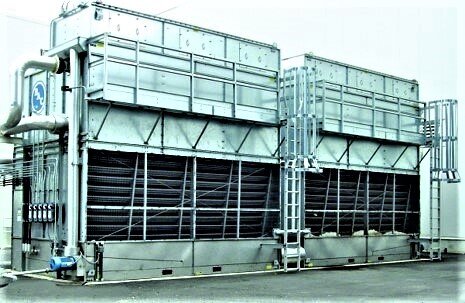WSHP System Control and Optimization Part 2: Freeze Protection Strategies for Cooling Towers
/By Chad Edmondson
Most commercial WSHP system will require a cooling tower, which can either be an open or a closed-circuit design. If the system is in a part of the country that periodically sees sub-freezing temperatures during the heating season, it must be designed and controlled with freeze protection in mind. Mother Nature can be particularly unforgiving to cooling towers when it is cold out, so it is best not to tempt fate. A cooling tower can freeze up in a surprisingly short period of time, damaging expensive equipment and resulting in unplanned downtime.
Open cooling towers and closed circuit cooling towers differ to “some” extent on the type of freeze protection they require. However, assuming the cooling tower is installed outdoors in a climate that is susceptible to freezing temperatures, the following measures apply to both:
• Do not operate the cooling tower when there is no cooling load. Keep in mind that in many buildings year-round cooling is required. However, the cooling tower should not operate unless there is some active cooling load. Without warm water flowing through the cooling tower, it is more susceptible to freezing.
• Cold water basins should be equipped with electric heaters to prevent the basin water from freezing. The heater should be sized for the coldest weather a geographical region may see – typically sized for 0°F or -20°F.
• Basin heaters should be equipped with a thermostat that will turn it on when the temperature drops below 40°F. A contactor is needed to activate the heater when the temperature drops below this set point.
• A low water cut-off control is required to prevent the heater from coming on if the basin is dry.
• The cooling tower fans should be equipped with a cut-off switch to stop rotation if the fan blades start to vibrate excessively due to ice formation.
• All outdoor cooling tower water piping and make-up water piping should be insulated and installed with heat tracing.
Additional Freeze Protection for Closed Circuit Towers
In addition to the above measures, closed circuit cooling towers require freeze protection of the internal heat exchanger if glycol is not being used in the hydronic system. We highly recommend providing positive closure dampers on all closed circuit cooling towers to minimize the heat loss from the heat exchanger to the outdoors when the tower is not operating. If water is used as the heat transfer medium, you will need to operate the cooling tower loop pump during periods of low temperature to provide a small amount of warm water thru the heat exchanger. With the dampers closed, this will keep the heat exchanger from freezing. Here is a typical freeze protection sequence for a closed circuit cooling tower:
Consider Glycol To Simplify Freeze Protection In a Closed Circuit Cooling Tower
The coils in a closed-circuit cooling tower heat exchanger can rupture if the heat exchanger freezes. That’s why most closed circuit cooling towers in the north use a mixture of water and glycol in the hydronic system to keep the fluid from freezing.
Although you lose a small amount of heat transfer capability, this mixture in the hydronic system reduces the freezing point. The mixture of glycol and water can be adjusted to change the freeze point to match the minimum temperature your system might see. It is important to check with the glycol manufacturer to see what percentage of glycol is recommended to prevent freezing at a given temperature.
While glycol may seem unnecessary in areas further south, keep in mind that if a facility loses power in an ice storm, it also loses operation of the pump, which keeps the heat exchanger from freezing. The addition of glycol in the hydronic system will prevent this scenario from happening and simplify the freeze protection.
Next up we are going to talk about alternative heat sinks for your system and how you can use the Earth as your hydronic battery.




